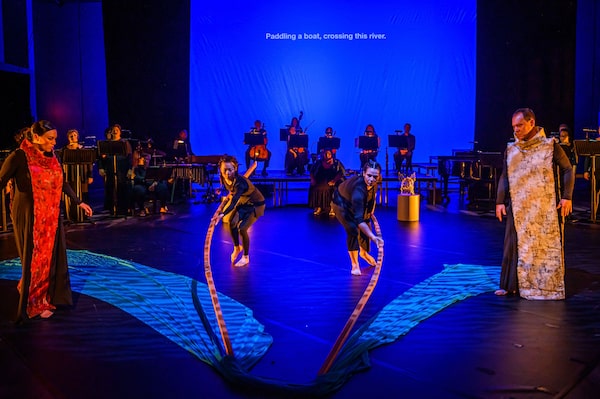
Land acknowledgments are often murky for non-Indigenous people.Dahlia Katz
In his program notes, co-director Cole Alvis throws a merciful lifeline in his description of Soundstreams’ current double-bill, Two Odysseys: Pimooteewin/Gállábártnit, co-produced with Signal Theatre and the Sámi National Theatre: “This production is a long-form land acknowledgment,” he writes.
Anyone who has gone to see live theatre or opera in Canada in the last handful of years has witnessed a land acknowledgment. It’s a moment at the beginning of the performance, dedicated to naming out loud the original people of the land underneath the venue, for the sake of remembrance and appreciation.
For non-Indigenous people, land acknowledgments are often murky. The names and places are unfamiliar, and, I can admit for myself, to hear them recognized inspires a confusing mix of curiosity and guilt. There’s a reason why these Indigenous peoples’ names are unknown to many Canadians, and that reason is not good at all.
There’s some of the same murkiness in experiencing these two operas, Pimooteewin and Gállábártnit, but at some deeper, more primordial level, they’re familiar. Pimooteewin (The Journey) is the first opera written in the Cree language, with music by Melissa Hui and text by Tomson Highway. Likewise, Gállábártnit (The Bear), with music by Britta Byström and text by Rawdna Carita Eira, is the first opera to set text in Sámi, the language of the Indigenous people of what is now northern Norway, Sweden, and Finland.
Pimooteewin asks two questions: Can the dead ever come back to the land of the living? And if they could, would they want to? It starts like a fable, with the coyote (tenor Bud Roach) and the eagle (soprano Melody Courage) travelling to the land of the dead; there, they collect the dead souls into a basket, and begin their journey back out. The dead protest, however, and escape from the basket, answering those big questions with a disheartening “no.”

The simplicity of these stories drew me in, a white woman born in Ontario, leaving me rapt for the duration and in awe of the execution of it all.Dahlia Katz/Handout
Gállábártnit is about a human woman, Áile (Melody Courage), who falls in love with Guovžža, a bear (tenor Asitha Tennekoon). The two live together and start a family; after several years away from her own people, Áile returns to have them meet her three bear sons. While Áile is with her family, and debating with them where her true home is, Guovžža is killed in her people’s hunt. Áile follows him in the way she can, joining him in the sky among the Northern Lights and the stars.
The two operas, collectively dubbed Two Odysseys, are a near-perfect fit for a double-bill. From the slants of their respective Indigenous cultures, Pimooteewin and Gállábártnit tell stories of living people who venture in and back out of the realm of the dead. The operas are each written with the music and text wholly integrated, neither element capable of being pried from the other. And both tales are presented by co-directors Cole Alvis and Michael Greyeyes as a canvas for storytelling devices. Masks, beautifully simple imagery, repetition and cyclic form; it’s incredibly evocative and, even for non-Indigenous audiences, nostalgic.
One gets the feeling one is seeing an extraordinarily true account of these ancient stories. Tomson Highway is Cree, and Rawdna Carita Eira is Sámi, meaning we get text written by those who speak the language, an irreplaceable portal of sorts that can connect these obscure cultures to Toronto in 2019. And the texts are delivered by Alvis, Greyeyes, and the other Indigenous artists scattered across the stage, making the whole thing feel mysteriously first-hand.
I found myself in awe of the storytelling elements, and their ability to reach even me, a white woman born in Ontario. The simplicity of these stories drew me in, leaving me rapt for the duration and in awe of the execution of it all. The two scores of Pimooteewin and Gállábártnit seem to be no easy feats, and one must send significant nods toward the singers, orchestra, and the ubiquitous chorus, all led by musical director David Fallis.
Awe and admiration come in generous amounts for these Two Odysseys, but strangely, the effect stops just short of emotional release. The tales are fascinating, almost like studies in storytelling, but their iconography and symbolic, legend-like status keep the characters archetypal rather than tangible. It’s confusing, the richness of the production paired with the arm’s-length limitation on emotional catharsis.
Still, Pimooteewin and Gállábártnit linger in the mind. There are details to admire, and a childlike abandon in hearing very, very old stories told back-to-back. After all, any great story is at least a little bit timeless.
Live your best. We have a daily Life & Arts newsletter, providing you with our latest stories on health, travel, food and culture. Sign up today.